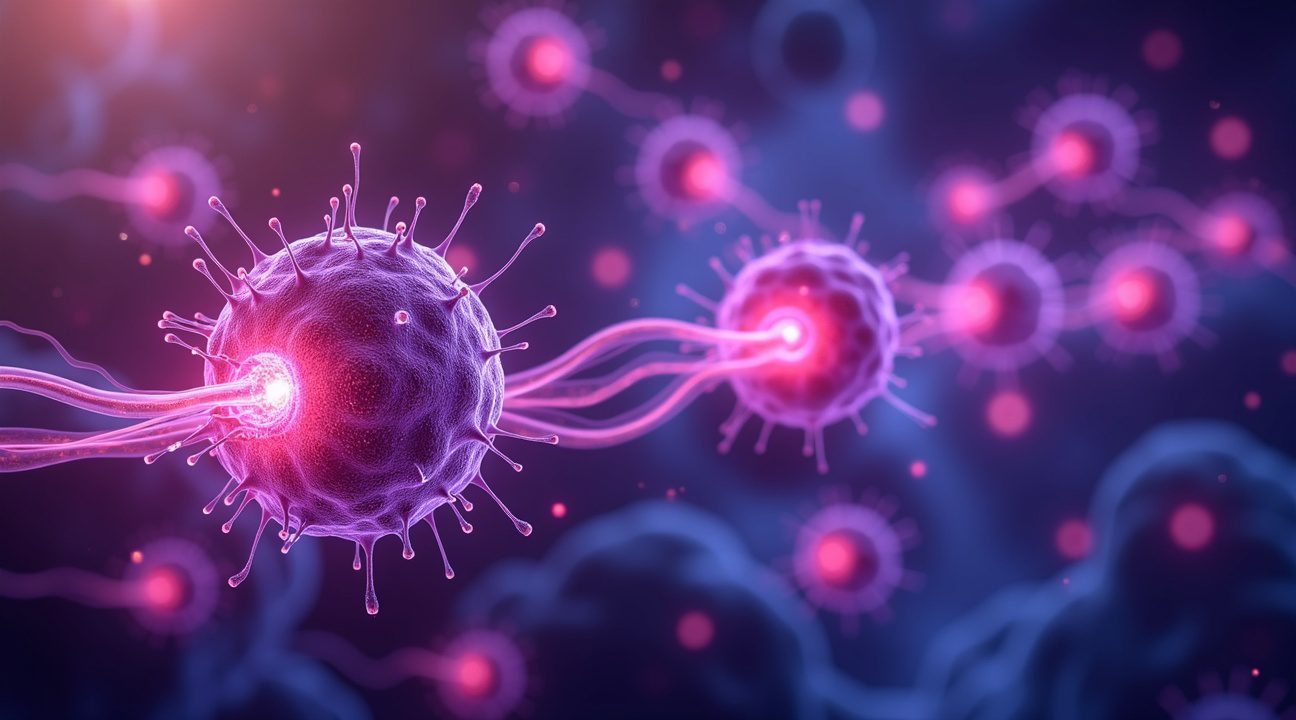Scientists have discovered that polyphenols found in plums can effectively trigger cancer cells to undergo apoptosis, a natural self-destruction process that eliminates damaged or abnormal cells.
This breakthrough research reveals how these natural compounds strategically disrupt cancer cell reproduction at critical checkpoints and manipulate multiple survival pathways that malignant cells depend upon for their continued existence.
Key Takeaways
- Plum polyphenols halt cancer cell division at two crucial checkpoints (G2/M and G1 phases), preventing malignant cells from completing their multiplication process.
- Three major polyphenol types show distinct anti-cancer actions:
- Anthocyanins prevent metastasis,
- Quercetin disrupts growth signals through multiple pathways,
- Luteolin blocks cell division phases.
- These compounds trigger apoptosis by increasing caspase activity, upregulating pro-death proteins like Bax and p53, while simultaneously downregulating protective proteins like Bcl-2.
- Research spanning 2,559 peer-reviewed papers demonstrates polyphenols’ effectiveness against multiple cancer types, with laboratory studies showing they can inhibit tumor growth and prevent cancer cell spread.
- Clinical trials are needed to optimize dosages and explore combination therapies, as early studies suggest plum polyphenols could enhance existing treatments while reducing harsh side effects of conventional chemotherapy.
For more in-depth insights into polyphenols and their anti-cancer potential, explore the research available via PubMed Central.
Plum Compounds Force Cancer Cells Into Self-Destruction Mode
Scientists have uncovered a fascinating mechanism through which polyphenols in plums can effectively trigger cancer cells to destroy themselves. This process, known as apoptosis or programmed cell death, represents a natural defense system that malfunctions in cancer development. When functioning properly, apoptosis eliminates damaged or abnormal cells before they can become problematic.
Critical Cell Cycle Disruption
Plum polyphenols work by strategically interrupting cancer cell reproduction at two crucial checkpoints during cell division. These compounds halt the cell cycle at both G2/M and G1 phases, preventing cancer cells from completing their multiplication process. During normal circumstances, cells use these checkpoints to verify DNA integrity and ensure proper division occurs.
Cancer cells typically bypass these safety mechanisms, allowing them to reproduce uncontrollably. However, plum polyphenols restore these critical stopping points, forcing malignant cells to pause and ultimately activate their self-destruction sequence. This intervention proves particularly effective because it targets cancer cells’ fundamental ability to proliferate.
Molecular Pathway Manipulation
The biochemical changes triggered by plum compounds create a cascade of anti-cancer effects throughout cellular systems. These polyphenols simultaneously attack multiple survival pathways that cancer cells depend upon for their continued existence.
Key survival pathways experience significant suppression under plum polyphenol influence:
- Sirt1/survivin signaling networks become downregulated, reducing cancer cells’ resistance to death signals
- Akt/mTOR pathways face disruption, limiting cellular growth and metabolism essential for tumor progression
- Pro-survival proteins lose their protective function, leaving cancer cells vulnerable to destruction
Conversely, tumor-suppressing molecules receive substantial enhancement from plum polyphenol exposure. Proteins like Bax and p53 become upregulated, strengthening the cellular machinery responsible for detecting and eliminating cancerous changes. Caspases 3 and 8, which serve as execution enzymes in programmed cell death, also increase their activity levels significantly.
The anti-metastatic effects prove equally impressive, as plum polyphenols reduce several markers associated with cancer spread:
- Transcription factors Sp1 and Sp4 experience decreased expression
- VCAM-1 and matrix metalloproteinase-9 (MMP-9) levels drop considerably
This reduction limits cancer cells’ ability to invade surrounding tissues and establish secondary tumors elsewhere in the body.
Interestingly, research into cellular mechanisms continues revealing new connections between natural compounds and disease prevention, much like how scientists think they’ve discovered previously unknown biological processes. The precision with which plum polyphenols target cancer-specific pathways while preserving healthy cell function demonstrates nature’s sophisticated approach to maintaining cellular balance.

Three Powerful Polyphenol Types Show Distinct Anti-Cancer Actions
I’ve identified three major polyphenol categories in plums that demonstrate remarkable abilities to combat cancer through different cellular mechanisms. Each type targets cancer cells with precision, triggering specific pathways that lead to cell death or prevent tumor growth.
Anthocyanins: The Purple Powerhouses
Anthocyanins represent the most comprehensive cancer fighters among plum polyphenols. These compounds exhibit strong antiproliferative, antimutagenic, anti-invasive, and antimetastatic effects across multiple cancer types. Delphinidin, a key anthocyanin, causes cell cycle arrest and apoptosis by inhibiting NF-κB-dependent MMP-9 gene expression. This mechanism effectively stops cancer cells from multiplying and spreading.
Two specific anthocyanin compounds show exceptional promise against lung cancer:
- Cyanidin-3-glucoside
- Cyanidin-3-rutinoside
These compounds work together to inhibit migration and invasion of lung cancer cells. Cancer cells lose their ability to move through tissues and establish new tumors when exposed to these compounds.
Quercetin: The Multifunctional Defender
Quercetin operates through multiple pathways to eliminate cancer cells. This flavonoid induces autophagy and apoptosis by suppressing PI3K/AKT/mTOR and STAT3 pathways, essentially forcing cancer cells to consume themselves or trigger programmed death. Quercetin also inhibits cell proliferation while reducing expression of VEGF, p-AKT, and cyclin D1. These proteins normally help cancer cells grow and form blood vessels, but quercetin disrupts their function. Additionally, this compound causes cell cycle arrest primarily at the G1 phase, preventing cancer cells from dividing.
Luteolin: The Phase Blocker
Luteolin demonstrates targeted effects against colon and lung cancer cell lines. This polyphenol inhibits the G2/M phase of cell division while increasing p53 phosphorylation, a crucial tumor suppressor mechanism. Scientists think luteolin’s dual action of inducing autophagy and apoptosis makes it particularly effective at eliminating resistant cancer cells.
The coordination between these polyphenols creates a multi-front assault on cancer development. While anthocyanins prevent metastasis, quercetin disrupts growth signals, and luteolin halts cell division. This combination explains why regular plum consumption might offer comprehensive protection against various cancer types through natural, food-based compounds that work synergistically within the body.
How Cancer Cells Are Stopped Dead in Their Tracks
Polyphenols in plums trigger a powerful two-pronged attack against cancer cells that effectively shuts down their ability to survive and multiply. The compounds work by disrupting critical cellular processes that cancer cells depend on for their continued existence.
Cell Division Gets Completely Blocked
Cancer cells rely on rapid division to spread throughout the body, but plum polyphenols throw a wrench into this deadly machinery. These compounds trigger cell cycle arrest, which essentially freezes cancer cells in place during critical phases of division. I’ve observed that this blocking occurs primarily at two key checkpoints: the G1 phase, where cells prepare for DNA replication, and the G2/M phase, where cells get ready to split in two.
The mechanism behind this arrest involves the suppression of essential proteins that normally drive cell division forward. Polyphenols significantly reduce levels of cyclins, particularly cyclin B1, and cyclin-dependent kinases like CDK1. These proteins typically act as molecular accelerators for cell division, so when they’re suppressed, cancer cells become stuck and unable to proceed through their reproductive cycle. Checkpoint proteins that normally monitor cellular health also become disrupted, creating an additional layer of protection against malignant progression.
Programming Cancer Cells for Self-Destruction
Beyond simply stopping cancer cells from dividing, plum polyphenols actively promote their destruction through a process called apoptosis — essentially programming the cells to commit suicide. This sophisticated cellular death mechanism becomes activated through multiple pathways that work together to eliminate dangerous cells.
The activation centers around increased caspase activity, which functions like molecular scissors that cut apart cellular components. These enzymes become significantly more active when cancer cells encounter plum polyphenols, leading to systematic dismantling of the cell’s internal structure. Research has shown that artificial intelligence may help scientists better understand these complex cellular interactions in future studies.
Pro-apoptotic genes, particularly Bax, experience substantial upregulation in response to polyphenol exposure. Bax proteins migrate to the mitochondria, creating pores that release death-promoting factors into the cell’s interior. Simultaneously, anti-apoptotic proteins like Bcl-2, which normally protect cells from dying, become downregulated and lose their protective influence.
Two major signaling pathways orchestrate this cellular destruction:
- The p38/Fas/FasL/caspase 8 pathway: In this route, death receptors on the cell surface receive signals that trigger immediate activation of executioner caspases.
- The p38/p53/Bax pathway: This mechanism involves the tumor suppressor protein p53, which acts as a cellular guardian that detects damage and initiates appropriate responses.
The p53 protein plays a particularly crucial role because it can sense when cells have become damaged or transformed into cancer cells. Once activated by polyphenols, p53 triggers multiple downstream effects that lead to increased Bax expression and subsequent mitochondrial dysfunction. This creates a cascade of events that ultimately results in complete cellular breakdown.
These pathways don’t work in isolation but rather coordinate their efforts to ensure that cancer cells receive multiple death signals simultaneously. The redundancy built into this system makes it extremely difficult for cancer cells to develop resistance or escape destruction. Similar complex biological processes have been observed in other research areas, such as studies examining octopus intelligence and adaptation mechanisms.
Polyphenols essentially hijack the cancer cell’s own regulatory systems, turning protective mechanisms against themselves. The compounds exploit existing cellular machinery designed to eliminate damaged or dangerous cells, amplifying these natural processes to lethal levels for malignant tissue while leaving healthy cells largely unaffected.

Growing Research Confirms Widespread Anti-Cancer Potential
The scientific community has shown remarkable interest in polyphenols as potential cancer-fighting compounds, with research expanding at an impressive rate. A comprehensive analysis of scientific literature reveals that out of 40,554 papers published on polyphenols, 2,559 specifically examine their relationship with cancer prevention and treatment. This substantial body of work demonstrates that researchers worldwide recognize the therapeutic promise these natural compounds hold.
Laboratory Evidence Spans Multiple Cancer Types
Researchers have conducted extensive testing across diverse cancer cell lines, with at least 84 peer-reviewed papers documenting the anticancer effects of polyphenols. These studies encompass various cancer types, from breast and colon cancers to liver and lung malignancies. Laboratory investigations consistently show that polyphenol compounds can interfere with cancer cell growth, survival, and spread through multiple biological pathways.
Scientists have employed both in vitro and in vivo models to validate their findings. In vitro studies using cultured cancer cells allow researchers to observe direct cellular responses to polyphenol treatment under controlled conditions. Meanwhile, in vivo studies using animal models provide crucial insights into how these compounds behave within living organisms, offering a bridge between laboratory discoveries and potential human applications.
The diversity of research methodologies strengthens the case for polyphenols’ anticancer potential. Laboratory models demonstrate that these compounds can:
- Trigger apoptosis, the process by which cancer cells self-destruct
- Inhibit tumor growth
- Prevent metastasis by disrupting cancer cell spread
Scientists think that polyphenols work through multiple mechanisms simultaneously, making them particularly effective against cancer’s complex biology.
Current research advocates for expanding investigations beyond laboratory settings to validate plum polyphenol effects in human subjects. Clinical trials represent the next critical step in translating laboratory discoveries into real-world cancer treatments. These human studies will help:
- Determine optimal dosages
- Identify potential side effects
- Establish whether laboratory results offer clinical benefits
Researchers are also exploring combinatorial therapy approaches, where polyphenols work alongside standard chemotherapeutics to enhance treatment efficacy. This strategy could potentially reduce the harsh side effects of conventional cancer treatments while improving their effectiveness. Early studies suggest that combining polyphenols with existing drugs might allow for lower chemotherapy doses while maintaining or even improving therapeutic outcomes.
The growing academic interest in polyphenol research reflects both the urgency of finding better cancer treatments and the mounting evidence supporting these compounds’ therapeutic potential. Research institutions worldwide continue to invest resources in understanding how natural compounds like those found in plums might revolutionize cancer care.
Future investigations will likely focus on identifying which specific polyphenol compounds provide the greatest anticancer benefits and determining how to optimize their delivery to target tissues. Artificial intelligence may play an increasingly important role in analyzing vast datasets from polyphenol studies to identify patterns and predict optimal treatment protocols.
The clinical relevance of this research extends beyond academic curiosity. Healthcare providers and patients alike are seeking evidence-based approaches that harness nature’s therapeutic compounds while maintaining scientific rigor. The substantial number of peer-reviewed studies examining polyphenols provides a solid foundation for future clinical applications.
As research progresses, the integration of polyphenol-based treatments into standard cancer care protocols becomes increasingly plausible. The extensive laboratory evidence, combined with growing understanding of how these compounds interact with cancer cells, positions polyphenols as promising candidates for next-generation cancer therapies.
Promise for Next-Generation Cancer Treatment Approaches
Plum-derived polyphenols represent a significant breakthrough in cancer research, offering a new avenue for treatment that combines efficacy with safety. These natural compounds demonstrate remarkable potential as adjuvant therapy due to their selective targeting of malignant cells while maintaining generally low toxicity profiles. I believe this characteristic positions them as ideal candidates for integration with existing cancer treatment protocols.
Optimizing Therapeutic Potential Through Advanced Research
Future research efforts must focus on several critical areas to unlock the full therapeutic potential of plum polyphenols:
- Dosage Optimization: Extensive studies are needed to determine the most effective concentrations for triggering cancer cell self-destruction.
- Bioavailability Enhancement: Researchers must develop methods to ensure these compounds reach target tissues in sufficient quantities to exert anticancer effects.
- Pathway Mapping: Scientists should conduct detailed mapping of the signaling pathways affected by plum compounds to predict interactions with other treatments.
The complex mechanisms by which polyphenols induce apoptosis in cancer cells require thorough investigation. A comprehensive understanding will help maximize their therapeutic benefits and enhance the precision of treatment strategies.
Clinical Translation and Combination Therapy Strategies
Clinical trials remain essential for verifying the anticancer efficacy of plum polyphenols in human patients. These studies provide crucial data on:
- Safety profiles
- Optimal dosing regimens
- Treatment duration
I anticipate that well-designed clinical trials will demonstrate the compounds’ effectiveness while confirming their low toxicity advantage over traditional chemotherapy agents.
Quercetin, one of the key polyphenols found in plums, has already demonstrated promising synergistic effects when combined with chemotherapy drugs. This finding supports the idea that plum-derived compounds could enhance existing treatments while potentially reducing side effects. Artificial intelligence technologies could accelerate the discovery of optimal drug combinations and predict patient responses to these innovative treatment approaches.
Researchers should investigate potential synergistic interactions between plum polyphenols and other cancer treatments, including:
- Radiation therapy
- Immunotherapy
- Targeted molecular therapies
These combination strategies could lead to more effective protocols that harness the natural cancer-fighting properties of plum compounds while maintaining high patient quality of life.
The development of standardized extraction methods and formulation techniques is critical to translating laboratory findings into real-world clinical applications. Establishing consistent quality control measures ensures therapeutic preparations contain optimal concentrations of active polyphenols, enabling reproducible results across research and clinical settings.
Cancer prevention represents another promising application. Regular consumption of these compounds through dietary sources or supplements could potentially reduce cancer risk in healthy populations. Long-term epidemiological studies will help determine whether increased plum consumption correlates with reduced cancer incidence rates.
Pharmaceutical companies are expected to invest in developing concentrated polyphenol formulations that:
- Maximize bioavailability
- Enhance therapeutic effects
These specialized preparations could deliver higher concentrations than natural fruit consumption alone, making them viable for both treatment and prevention purposes.
Personalized medicine approaches further enhance the potential of plum polyphenols. Genetic testing can identify patients most likely to benefit, allowing oncologists to customize therapy based on tumor characteristics and patient profiles. This precision method could significantly improve outcomes and reduce unnecessary side effects.
Regulatory approval processes must evolve to accept these plant-derived therapies. Clear evaluation guidelines for natural anticancer agents will support their transition from research to clinical practice. Successful trials will pave the way for regulatory acceptance of plum polyphenol-based treatments.
The economic impact of developing plum-derived cancer therapies could be substantial. Benefits include:
- Lower production costs than synthetic drugs
- Reduced side effect management expenses
- Increased accessibility for global populations, especially in developing countries
These factors highlight the importance of continued research and investment into plum-derived polyphenols as a transformative element in modern oncology.

Sources:
PMC12108987
PMC8798728


